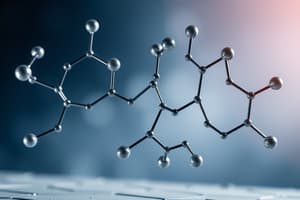Podcast
Questions and Answers
Which of the following correctly describes the composition of carbohydrates?
Which of the following correctly describes the composition of carbohydrates?
What is the primary function of phospholipids in the food industry?
What is the primary function of phospholipids in the food industry?
Which food item is NOT commonly identified as a source of carbohydrates?
Which food item is NOT commonly identified as a source of carbohydrates?
From which process are carbohydrates synthesized in green plants?
From which process are carbohydrates synthesized in green plants?
Signup and view all the answers
Which of the following is the best-known phospholipid, commonly found in food?
Which of the following is the best-known phospholipid, commonly found in food?
Signup and view all the answers
What type of molecule is a sterol?
What type of molecule is a sterol?
Signup and view all the answers
Which of the following is NOT a common food source for carbohydrates?
Which of the following is NOT a common food source for carbohydrates?
Signup and view all the answers
Which carbohydrate structure is typically referred to as a basic unit?
Which carbohydrate structure is typically referred to as a basic unit?
Signup and view all the answers
Which of the following hormones is classified as a sterol?
Which of the following hormones is classified as a sterol?
Signup and view all the answers
Which of the following foods most likely contains lecithin?
Which of the following foods most likely contains lecithin?
Signup and view all the answers
Study Notes
Key Elements in Food
- Essential atoms include Carbon, Hydrogen, Nitrogen, Oxygen, Phosphorus, and Sulfur (CHNOPS).
- These elements are fundamental in forming organic materials and carbon-containing compounds.
Classification of Food
- According to source:
- Plant-based: Includes grains, cereals, pulses, fruits, vegetables, nuts, and fungi.
- Animal-based: Comprises muscle, milk, poultry, eggs, fish, and shellfish.
- Based on manufacturing methods:
- Primary processed foods: Derived from basic commodities through operations like milling or oil extraction.
- Preserved foods: Maintain natural forms but treated to extend shelf life.
- Manufactured foods: Altered significantly from original sources.
Importance of Water in Food
- Water is the most abundant nutrient in many foods, comprising up to 95% of their composition.
- Fruits and vegetables contain between 70-95% water; whole milk exceeds 80%, while most meats hover around 70%.
Properties of Water
- Boiling point drops at higher elevations; at Mt. Everest, it is 69°C.
- Water's molecular composition consists of 2 hydrogen atoms and 1 oxygen atom (H2O).
Types of Water
- Free water: Easily separable, abundant in foods, e.g., found in fruits.
- Bound water: Integrated into nutrient structure, not easily removed, e.g., found in bread.
Functions of Water
- Serves as a medium for dissolving various substances (salts, acids, sugars).
- Essential for heat transfer in cooking using moist-heat methods (boiling, simmering, steaming).
Specific Physical Properties
- Water's high specific heat requires more energy to increase its temperature than most substances.
- This enables high-water-content organisms to endure extreme temperatures.
Surface Tension
- Water has significant surface tension, causing molecules to form drops rather than spreading.
- This trait is evident when water is placed in a cylinder, causing a concave meniscus.
Freezing Point
- Pure water freezes at 0°C (32°F).
- Lower temperatures decrease kinetic energy and result in a solid state.
Types of Dispersions
- Solutions: Homogeneous mixtures where solute particles dissolve fully in the solvent (e.g., sugar in water).
- Colloidal dispersions: Particles (like starches and gums) do not fully dissolve due to their size.
- Coarse dispersions: Larger particles remain suspended but visible.
Phospholipids and their Uses
- Phospholipids emphasize emulsification, allowing hydrophobic and hydrophilic substances to mix.
- Common in food products such as mayonnaise, baked goods, and beverages.
- Lecithin, found in egg yolks, is a notable phospholipid.
Composition of Carbohydrates
- Composed of Carbon, Hydrogen, and Oxygen (CHO).
- Synthesized in green plants via photosynthesis and structured in basic units called saccharides.
- Common food sources include grains, legumes, and various fruits and vegetables.
Role of Sterols
- Sterols are complex molecules composed of interlinked carbon rings with diverse side chains.
- Include substances like cholesterol and hormones (testosterone, estrogen) critical for various biological functions.
Studying That Suits You
Use AI to generate personalized quizzes and flashcards to suit your learning preferences.
Related Documents
Description
This quiz focuses on the classification of foods and their key elements, encompassing the essential atoms that form organic compounds. Participants will explore concepts related to GMOs and the significance of CHNOPS elements in living material.




